If you come across a spider in your closet or while weeding your tomatoes you might wonder what kind of spider it is. Black widows are a well-known dangerous spider, but what about brown spiders? Are there any brown spiders in California that are poisonous? Let’s find out about 10 common brown spiders in California.

Does California have any dangerous brown spiders? Let’s find out.
©iStock.com/Christine944
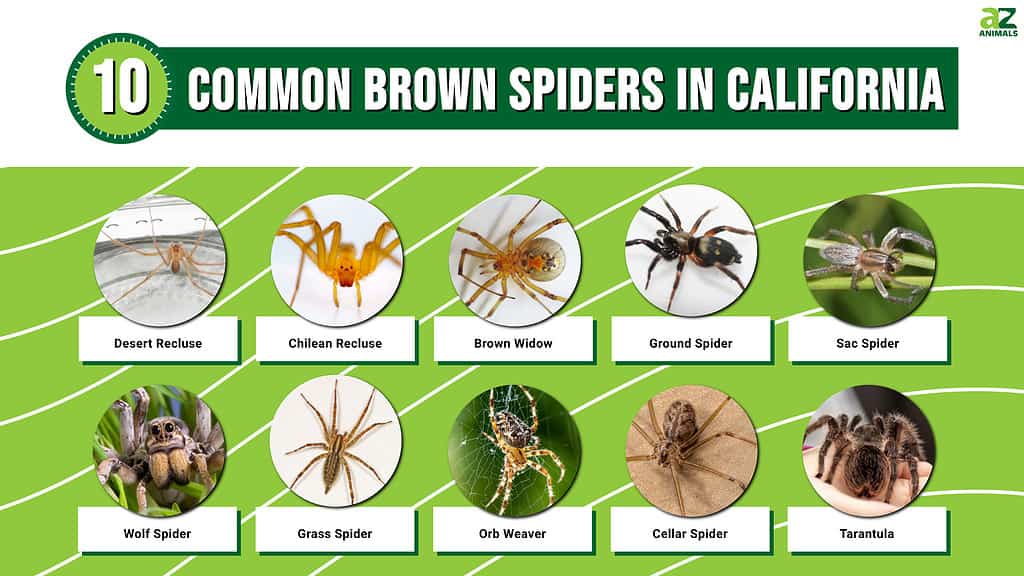
Are There Brown Recluse Spiders In California?
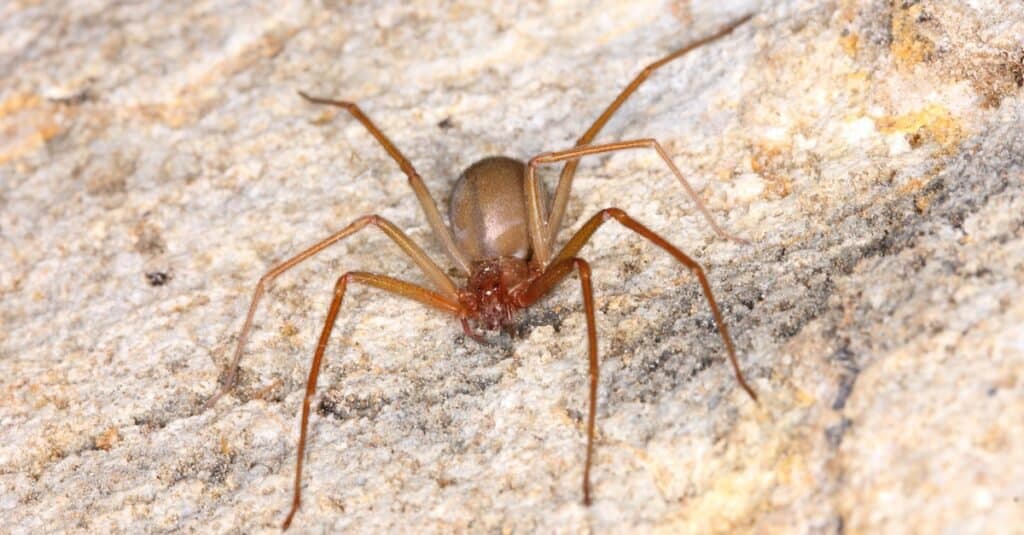
The brown recluse spider is one of the most dangerous spiders in the United States. Its venom destroys the walls of
blood vessels
near the site of the bite, sometimes causing a large skin ulcer.
©Pong Wira/Shutterstock.com
Brown Recluse spiders are not native to California. Despite media reports and social media postings, there are no populations of Brown Recluse spiders in California. Brown recluse are very venomous and can cause large ulceric sores that take weeks to heal. There are a few other dangerous brown spiders to be aware of but most common brown spiders in California are harmless. The three dangerous ones are the Desert recluse, Chilean recluse and Brown Widow.
Desert Recluse Spider
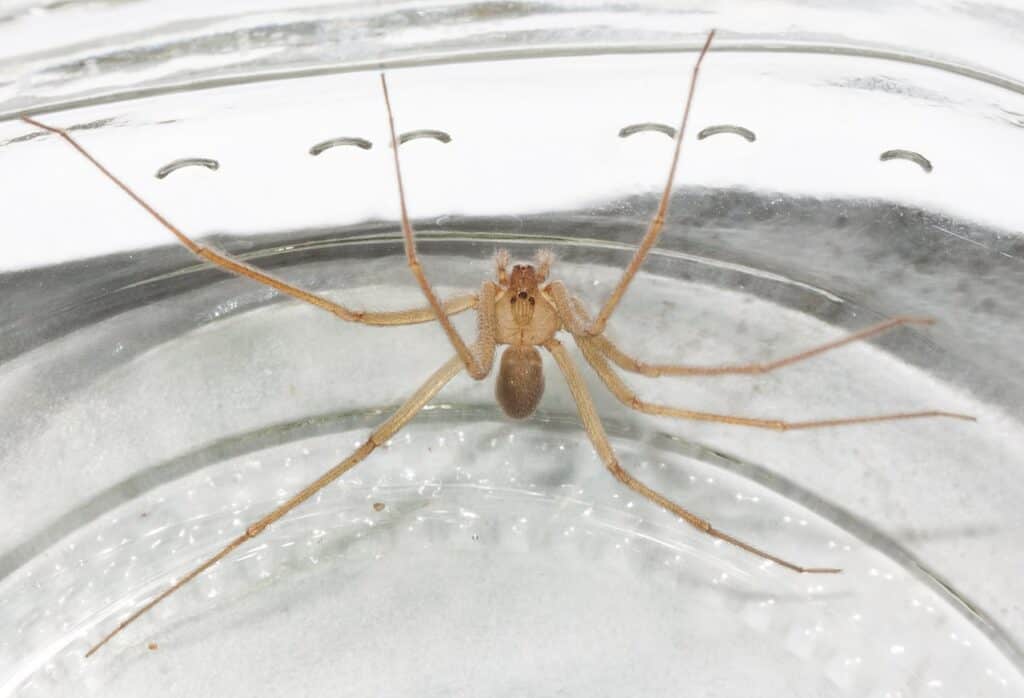
The Desert Recluse has six eyes (which appear as three eyes at first glance) and a violin-shaped design on the back of its head.
©DesertTrip / CC BY-SA 4.0, via Wikimedia Commons – License
The Desert recluse is related to the Brown recluse but its venom is not as potent. In California, they are located in the deserts in the eastern part of the state. Due to their desert habitat, they do not come in contact with people very often.
Chilean Recluse Spider
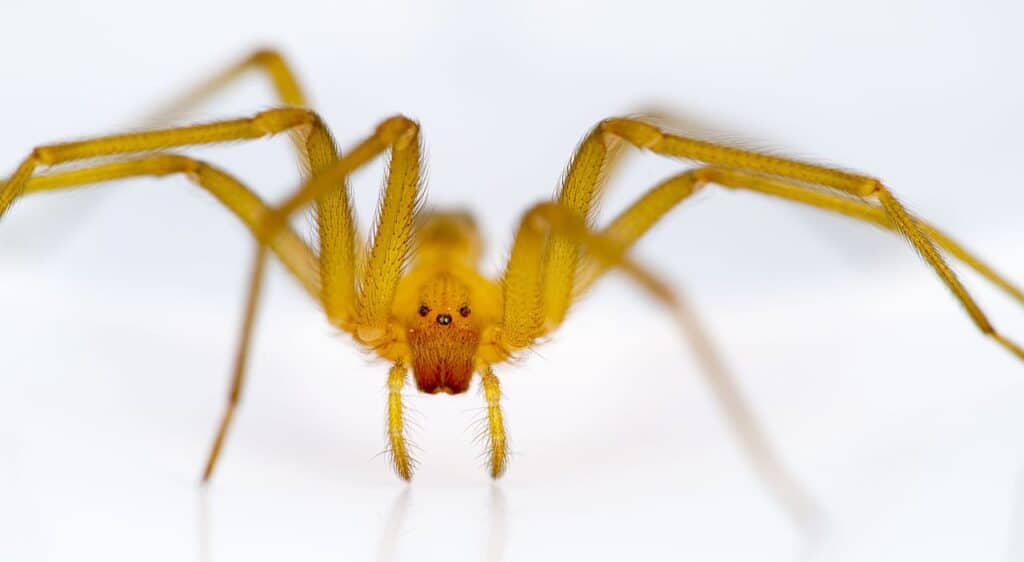
Not native to California, the Chilean recluse originates from South America.
©Ssiltane / CC BY-SA 4.0 – License
Although not common in California, there have been isolated populations of Chilean Recluses found in commercial buildings in the L.A. area. They are originally from South America but have made their way up to the U.S. Chilean recluse look similar to brown recluses with a violin shape on their back, but they can be more reddish brown and are larger than Brown recluses. They grow to be around 5/8 inch (15 mm).
Brown Widow Spider
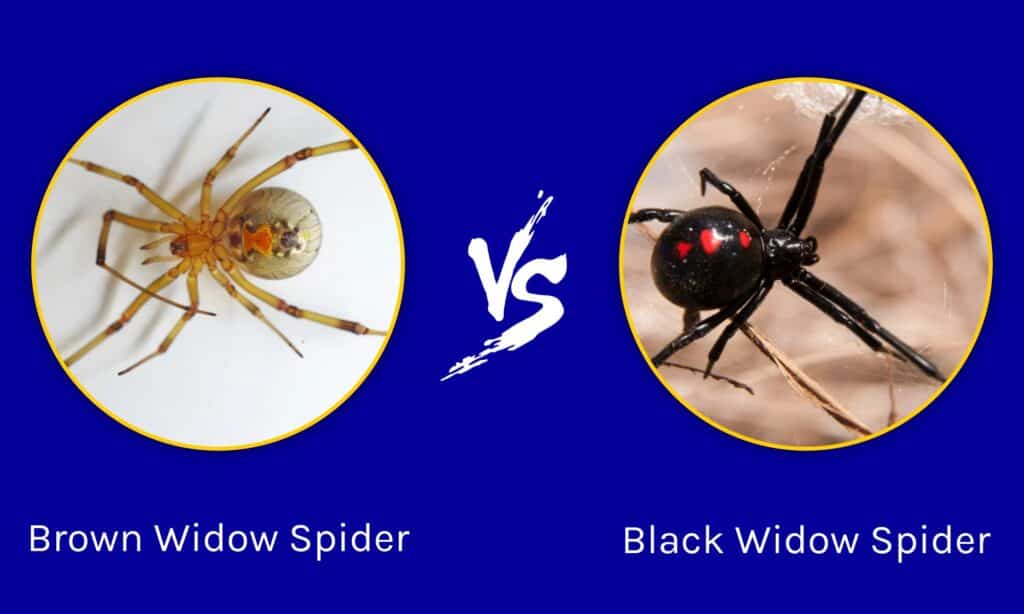
You have probably heard of Black Widow spiders but did you know there are Brown Widow spiders? Brown Widows are smaller than Black Widows with an average size of ½ -1 inch long. It is easy to tell them apart because Black Widows are a shiny jet black and Browns are tan to yellow-brown. Brown Widows are not aggressive but they will bite if they are threatened or startled. They are venomous but not nearly as harmful as Black Widows. Brown Widows are less common than Black Widows and have a limited range.
Ground Spider (Gnaphosidae)
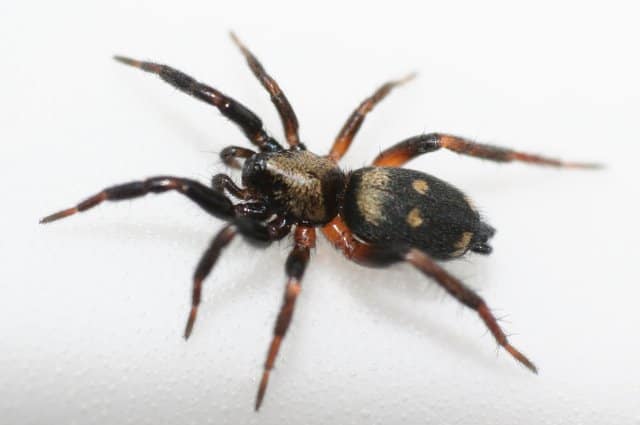
There are more than 2,000 species of ground spiders.
©Benedikt, CC BY-SA 2.0 <https://creativecommons.org/licenses/by-sa/2.0>, via Wikimedia Commons – License
Now on to some more common brown spiders that are not dangerous. With more than 2,000 species of ground spiders it is likely that the brown spider you see scooting across your garage floor when you pull your car in at night might be a Ground spider. They are nocturnal and don’t sit around waiting for dinner in a web. They are active hunters that use their web-spinning skills to capture prey, wrapping them in sticky webs before devouring them. Sounds scary until you find out that most are only about 8 mm-15 mm.
Sac Spider (Cheiracanthium spp.)

Sac spiders are less than a 1/2 inch and can be found in residential areas.
©Brett Hondow/Shutterstock.com
Smaller than ground spiders the Sac spiders (sometimes called yellow sac spiders) are around 5-10 mm (less than ½ inch). They can be light brown or have a yellow hue. They spin spherical webs, but are also active hunters. It is a spider that is found in residential areas and can hide in clothing or shoes that have not been used in a while. Always shake out clothes or shoes that may have been sitting unused before wearing.
Wolf Spider (Lycosidae)
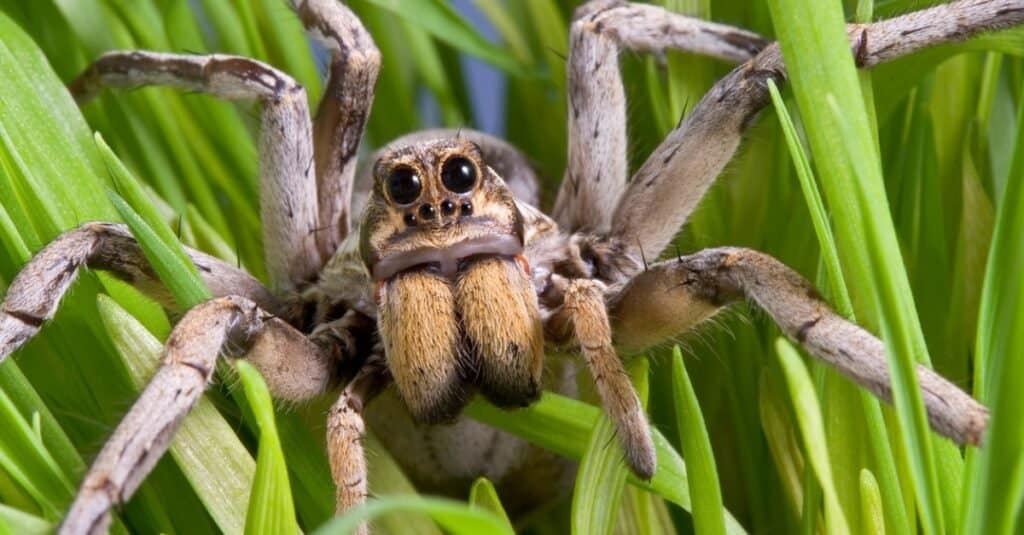
Wolf Spiders have two big black eyes and a series of four eyes below. They have two more above as well. These spiders look scary but are only about an inch long.
©iStock.com/CathyKeifer
You can recognize wolf spiders by their two round black eyes on top of their heads. They also have six more eyes with a row of four small ones below and two medium above. Wolf spiders are a good sized spider ranging in size from 10-35 mm (.4 – 1.38 inches). One of the unique characteristics is that when the spiderlings hatch they all climb up on the mothers back and ride around for a few weeks! If you see a spider with a day care on their back it is probably a Wolf spider!
Grass Spider (Agelenidae)
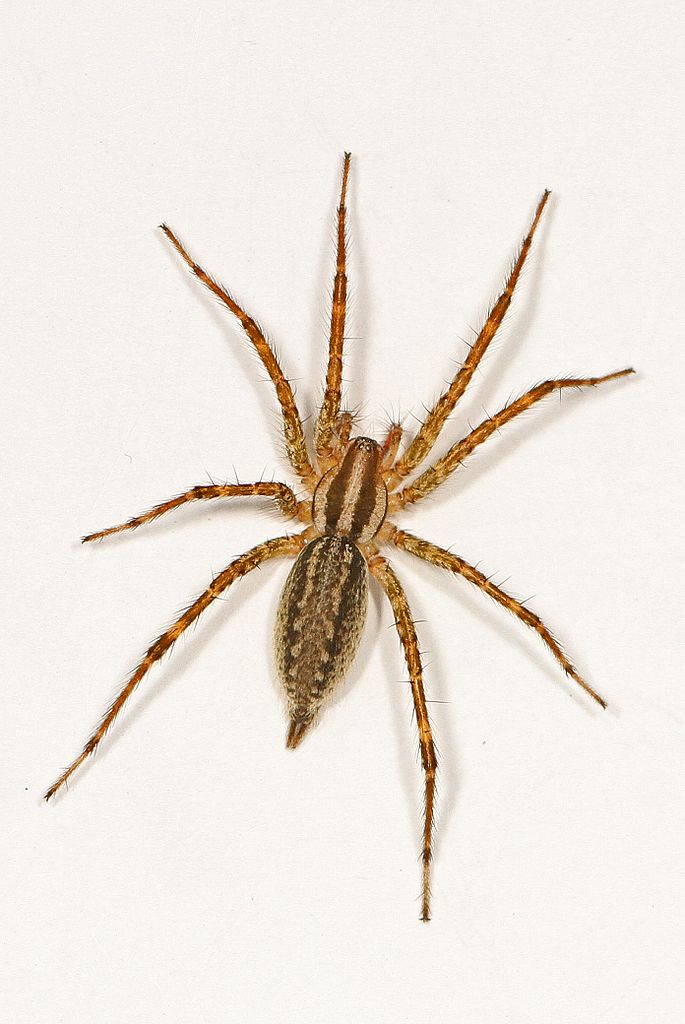
The harmless American grass spider is one of the most common spiders in the United States
©Judy Gallagher, CC BY 2.0 – License
Also known as “funnel-weavers” build their webs close to the ground, their unique webs are one way to tell them apart from other common brown spiders in California. Grass spiders get to be around 8-12 mm long and have eight eyes in two symmetrical rows. Their unique webs catch insects that fall into the funnel and get caught, providing dinner for the grass spider!
Orb Weaver (Araneidae)

Orb Weavers
build their large webs and then dangle below, hanging from a thread of silk.
©novama/Shutterstock.com
Orb-weavers spin some spectacular webs, some being more than three feet in diameter! There are more than 3,000 different orb weaver species. Many of them are brightly colored with yellow, blue and red markings while others are a common brown. Although they spend lots of time constructing their webs they do not stay in their webs. They hang down on a strand of silk and wait for prey to get tangled in the web.
Cellar Spider (Pholcus phalangioides)
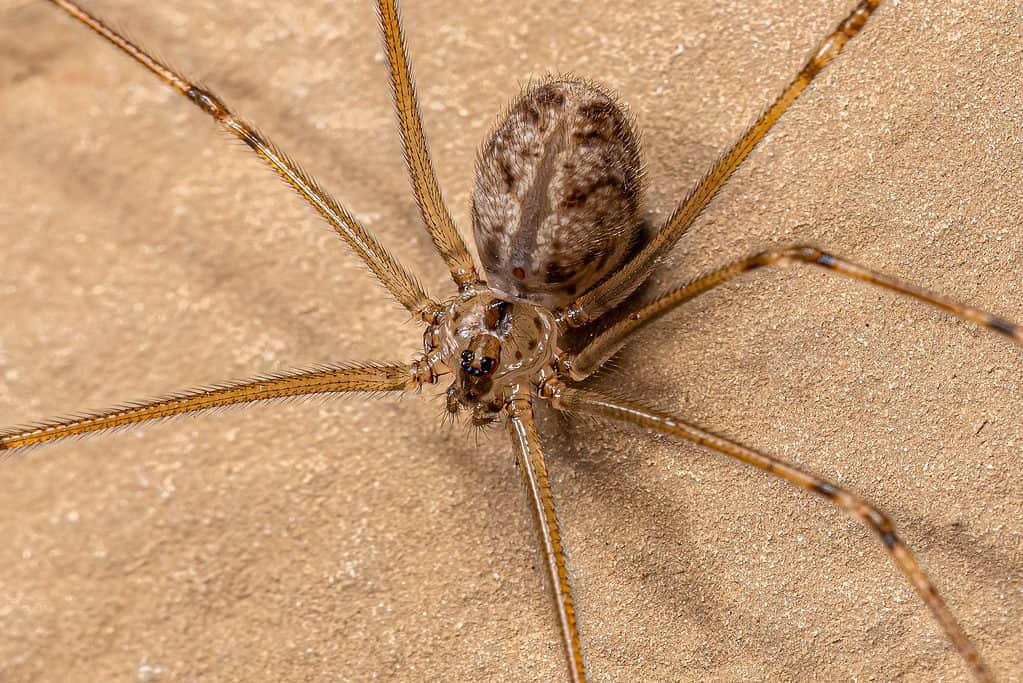
Short-bodied cellar spiders have long, skinny legs.
©Vinicius R. Souza/Shutterstock.com
These long-legged spiders are sometimes called “daddy-long legs” because of the long skinny legs that seem way too long for their body. Their bodies are around 6-10 mm and their legs stretch out even further. They are commonly found in residential areas including cellars which is how they got their name. You can find cellar spiders in every county in California, they prefer the warm humid climate that the state offers. They are preyed on by Jumping spiders keeping their numbers in check.
Tarantula (Aphonopelma spp.)
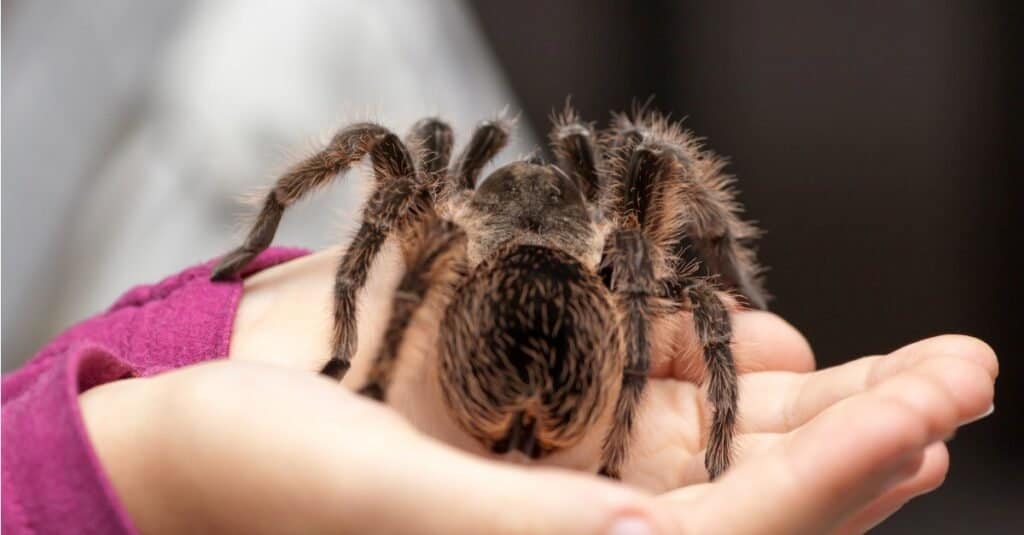
Tarantulas are one of the 10 common brown spiders in California. They are also one of the largest!
©iStock.com/waldru
Although some may not consider a hand-sized spider to be “common”, tarantulas are brown and do live in California. These large furry spiders can get to be 3-4 inches long! They are sometimes called desert tarantulas or California tarantulas. Although they look intimidating they are not harmful to humans. They can bite but it feels like a bee sting and they typically do not bite humans. During the mating season, many tarantulas make their way to Northern California, especially Mount Diablo State Park, especially during late August, early September. Keep your eye out for these common brown spiders in California!
Bonus: In case you read that last clip and you really want a hand-sized furry spider for a pet, read this pet tarantula guide for everything you need to know to have a pet tarantula!
Bonus: What Keeps Spiders Away
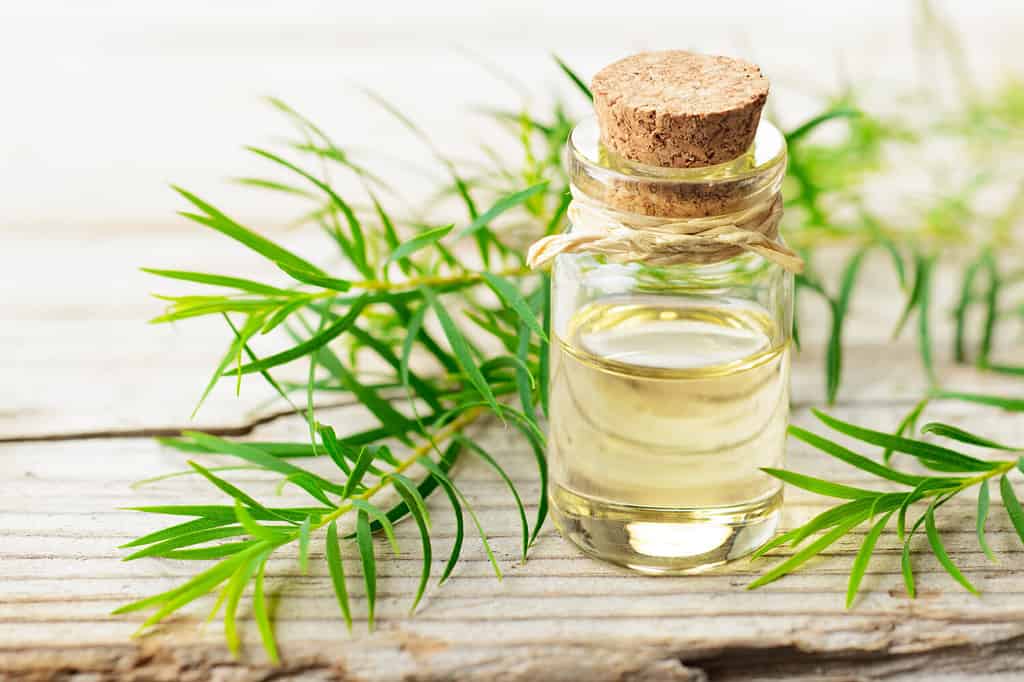
Tea tree oil is an excellent alternative to commercial pesticides, as the scent repels spiders.
©AmyLv/Shutterstock.com
One of a person’s worst nightmares is having spiders wind up in their home–especially the poisonous kind! The best way to avoid getting bitten by a spider is to try and prevent them from entering your house in the first place. As spiders can get into your home through holes and cracks, you can check for possible entryways with a flashlight. If the light gets through from the inside to the outside, you should fill that hole or crevice with an appropriate product.
Keeping your yard free of debris and overgrown vegetation helps cut down on areas spiders would gravitate to. Caulking doors and windows is also a good strategy to keep them out.
Spiders hate certain scents, so scented essential oils can help deter them like peppermint, tea-tree, lavender, and rose. You can add 15-20 drops of a particular oil in a water bottle mixed with water and spritz it around your house. They also hate the smell of cinnamon and vinegar, so these scents can be used similarly.
Rubbing lemon or orange peels on the baseboards along your walls, on window sills, and on other surfaces can also repel spiders, who dislike citrus smells. Furniture polish and cleaning products with lemon scent can also help.
Regular cleaning inside your home, especially in areas that are dark or less frequented, is necessary to keep spiders from setting up residence. It’s also important to keep an eye on fruit bowls, as they can attract spiders.
The photo featured at the top of this post is © novama/Shutterstock.com
FAQs (Frequently Asked Questions)
Are there tarantulas in California?
Although some may not consider a hand-sized spider to be “common”, tarantulas are brown and do live in California. These large furry spiders can get to be 3-4 inches long! They are sometimes called desert tarantulas or California tarantulas.
What is the more common name for a cellar spider?
These long-legged spiders are sometimes called “daddy-long legs” because of the long skinny legs that seem way too long for their body.
Thank you for reading! Have some feedback for us? Contact the AZ Animals editorial team.






